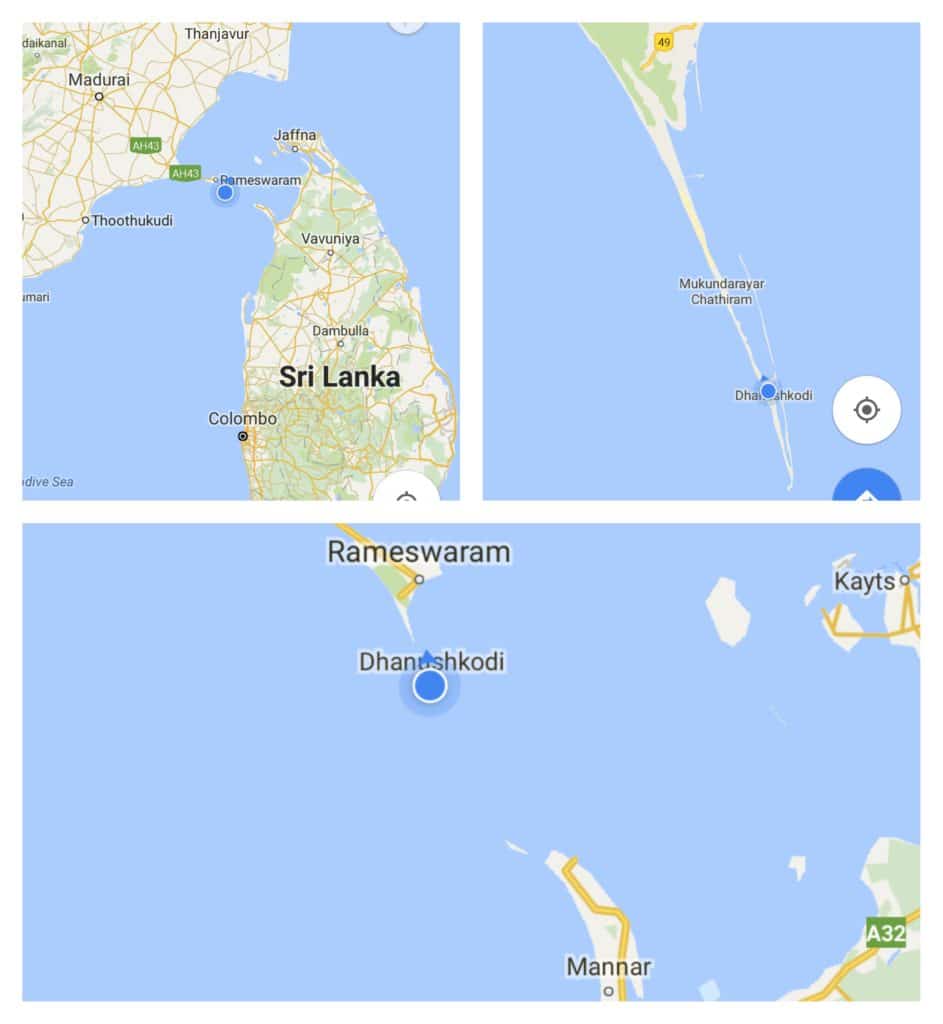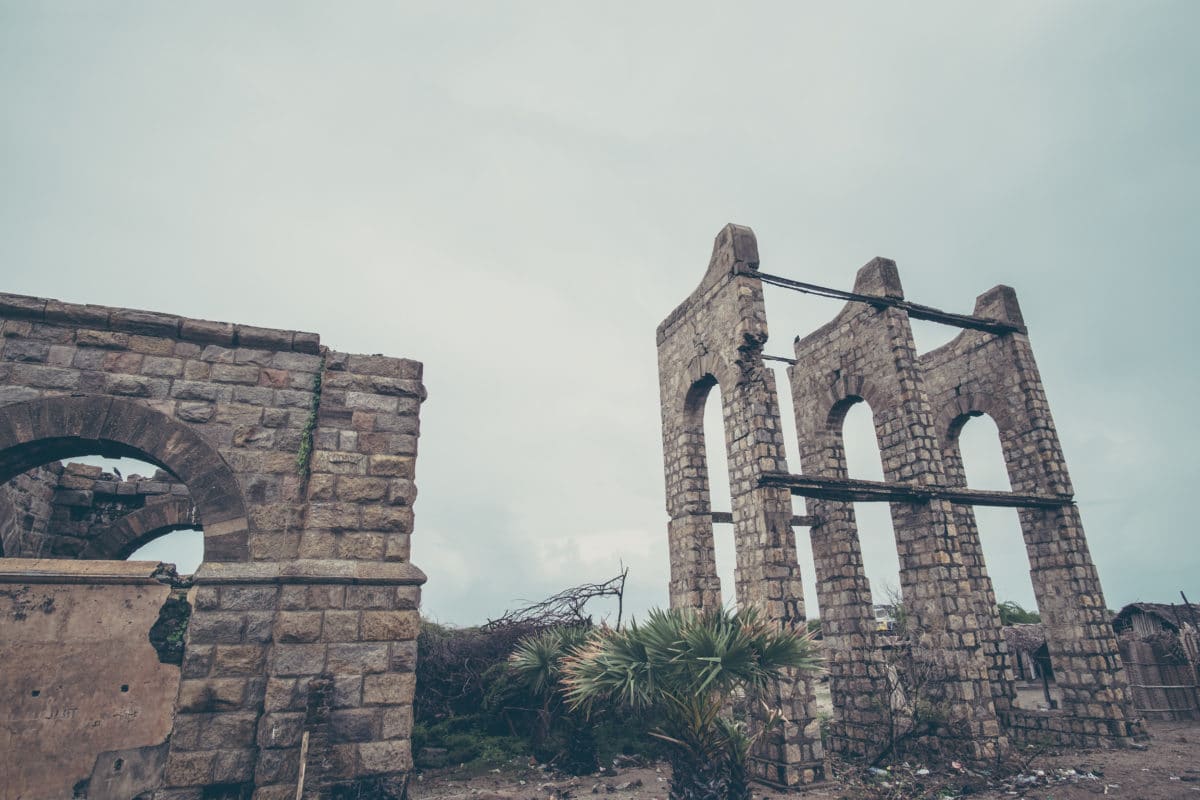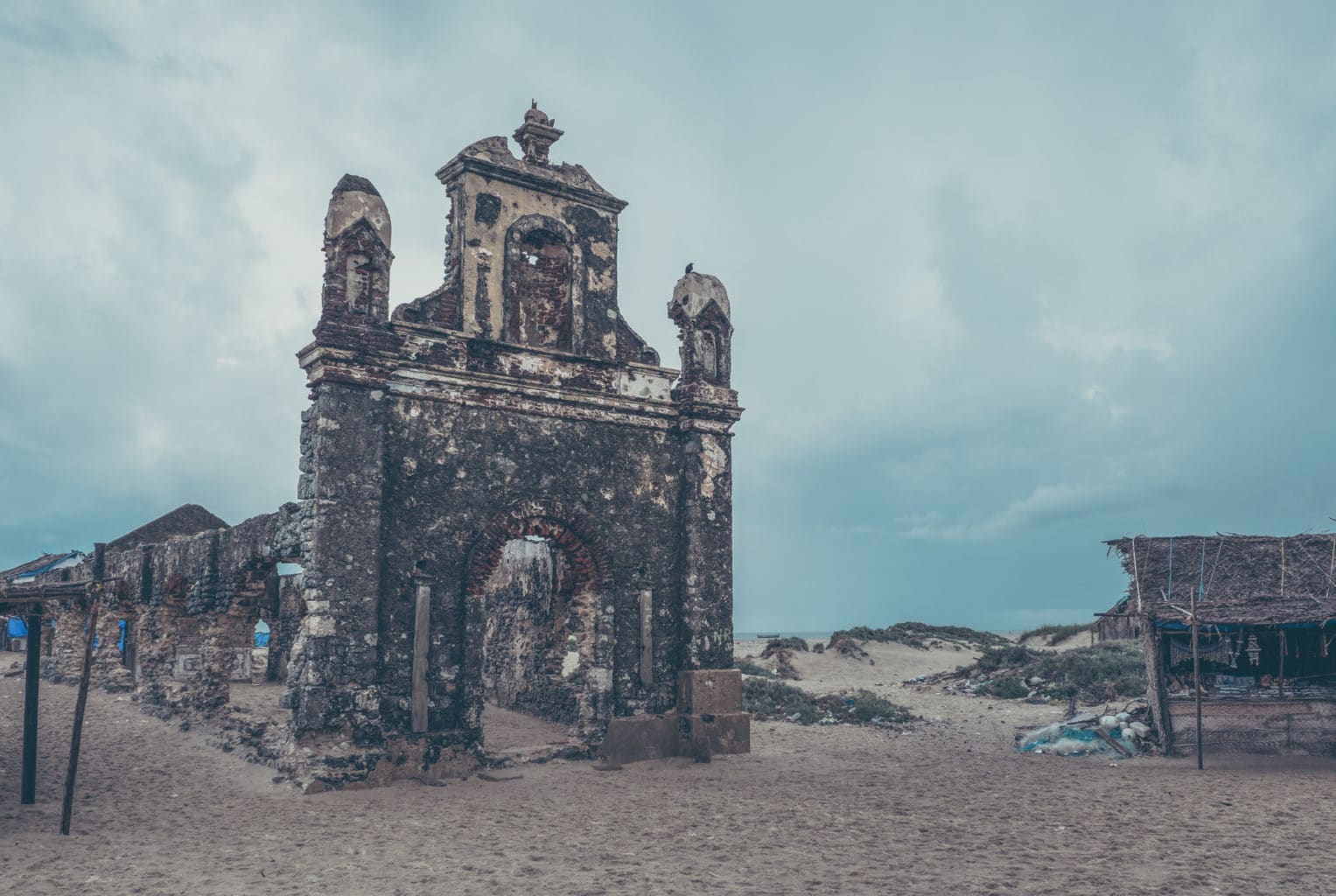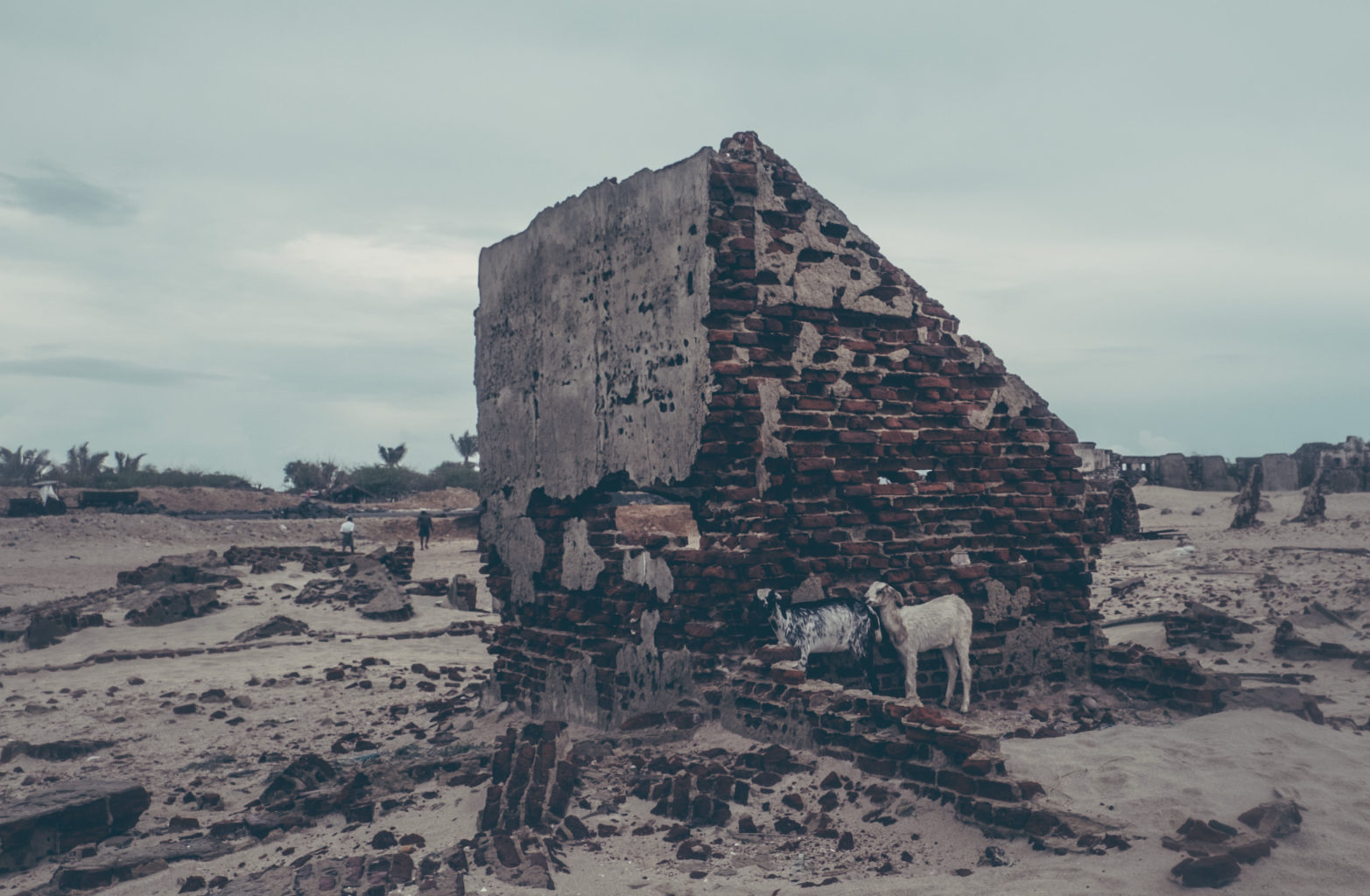On the eastern cost of Tamil Nadu, in Southern India, is a thin sliver of land, which protrudes into the sea like a needle pointing towards the Island country of Sri Lanka. This sliver of land is known as Dhanushkodi, and is accessible from the mainland through the Island of Pamban, also commonly known as Rameshwaram.
Dhanushkodi, no more than 10-15 Kms long has an importance in India mythology, far greater than the tiny land mass it occupies. For it is here that Lord Rama is said to have built his bridge to cross into Lanka with his army of monkeys and bears, to rescue his wife Sita captured by the King, Ravana. Of course to millions of Indians this is not mythology or folklore, but absolute truth, and interestingly geography, to some extent, seems to bear this out. Dhanushkodi from its tip, lies less that 30 kms from Sri Lanka. Moreover satellite images and geographic studies of the region show that from the tip of Dhanushkodi there exist a number of sandbanks, reefs and shoals that trace a fairly continuous line all the way to the Mannar Island of Sri Lanka. This geographic feature is referred to as Adams bridge, thought most of India would call it the bridge of Rama. Some historical accounts have even stated that, till the 15th century this ‘bridge’ was almost completely above water and could be crossed by foot until sections of it were washed away by a cyclone in 1480. Interestingly, some early Islamic texts and also the Encyclopaedia Britannica refer to a mountain in Sri Lanka called Adams mountain, where, depending on which version you subscribe to, Adam is said to have fallen from heaven and then crossed from Sri Lanka into India on ‘Adams bridge’ or alternatively said to have crossed Adams Bridge and stood atop the mountain, on one foot, repentant for a 1000 years. It is true when they said, you can’t make this stuff up!

A place with so much historical and mythological (and storytelling) significance clearly needed to be visited, and so we set out from Rameshwaram to explore the tip, commonly called Ramsethu. The journey, needless to say, was interesting. Once you head out from Rameshwaram town you travel on a narrow road which is surrounded on both sides by a thin strip of sand and then the sea. In parts you see low bushes and thorny shrubs, followed by the endless sea in a myriad shades of blue. The land in most parts is not more than 50 – 70 meters wide. After driving for about 20 kms, the road ends and you reach a spot where regular vehicles can go no further. From this point you need to transfer into a 4 x 4 minibus, as your journey is now over a series of sandbanks and this is where it gets quite surreal.
We pile into this minibus which is packed to capacity with an odd mix of pilgrims, day trippers, families, screeching children and the occasional curious, like us. The bus itself is a modified Mahindra vehicle that has seen better times. It smells of combustible kerosene fumes, has windows that are either stuck in place or simply don’t exist and metal benches. I sit on the front seat next to the driver and Ambika is squeezed in the seat behind, between three very excited children and their parents. Between me and the driver, perched on some sort of box over the gearshift, sits a man who peppers me in a mix of tamil (which I don’t understand) and broken english (which I just about decipher) with the usual questions. Are you Indian? Where are you from? What you do? Why only two of you? No children? Our conversation is thankfully exhausted rather quickly due to our limited shared vocabulary, and I stare out of my jammed window at the scene outside.

We meander for the most part on a narrow strip of beach, rocking violently from side to side, as waves lap at the wheels. Small birds splash around in the shallow waters, as eagles glide above, occasionally diving towards the white foam as they spot a catch. Ever so often the driver veers sharply into the water which elicits looks of horror from Ambika and whoops of excitement from the children. At various points in the journey the water is halfway up the wheel and splashes into the cabin from the gaping holes in the rusted floor. Whilst there may have been a good reason for the driver to steer off into the water, we can see no such logical explanation and surmise that this is a way for him to elevate his boredom, and also perhaps to give the occupants of the bus a sense of thrill and adventure. To increase the thrill quotient, the sky turns a foreboding grey, the wind picks up and the clouds start pelting us with rain. I struggle to shut my window as the children shriek and the driver shoots me a withering look. Somewhere along the way we come across a couple of bikers who are hopelessly stuck in the sand, and the driver grins malevolently and curses at them in Tamil with a “you-should-have-taken-my-rust-trap-you-morons” expression. The bikers glare back but cannot do much else as their noisy, macho Enfields rev, sputter and die, filling the air with fumes and sand.

Finally after 45 minutes of shake, rattle and roll, we reach the ghost town of Dhanushkodi, or rather what is left of it. Close to half a century ago a powerful cyclone swept this tiny little hamlet, killing most of its occupants and submerging large parts of the village. It has been uninhabited since. We walk amongst the ruins, clutching our jackets around us to protect against the constant rain which has slowed to a drizzle, and the cold wind which has picked up. A few odd structures remain – a large stone gate, the facade of what would have been a church, railroad tracks, courtyards and walls of broken homes. Because this is India, vendors sell tea, biscuits, seashells and trinkets, but there is no enthusiasm in their sales pitch; it is almost as if they feel the foreboding mood as well.

The dark grey skies and slow drizzle adds to the sense of melancholy as one reflects on the unpredictable fury of nature. What must it have been like to live here, so far from anything else, so close to the edge of land, at the mercy of the ocean. What would have possessed the inhabitants of Dhanushkodi to persist, on this thin sliver of land, surrounded by salt water, braving the elements, with what would surely have been an omnipresent threat of annihilation hanging over their heads? Could it have been the faith that they would be protected by their lord, or was it simply that they had lived there for centuries and it was home. We left with all sorts of thoughts swirling between us, trying to imagine the ghost town as a happier inhabited place, and hopped back into the van for another bumpy ride back to the cold comfort of civilisation.
Some Useful Information:
How to get there
Rameshwaram is well connect by train and road from Chennai, and by road from Bangalore, from Rameshwaram you can get to Dhanushkodi by Auto or your own vehicle. After a certain point you need to transfer out to shared 4 Wheel Drives as the last section to the abandoned town is all on the beach. It can get blazingly hot in the day so time your visit to catch the sunset.
Where to stay
You obviously can’t stay in Dhanushkodi, but there are any number of small hotels and lodges in the town of Rameshwaram around the temple. However if you are looking for a relaxed beach experience in a slightly offbeat location we would recommend staying at Quest Expeditions property at Pamban, a beautiful beach with stunning blue waters, about 13 Kms away from Rameshwaram station (an auto to Pamban costs about Rs. 250 – 300). There are two properties, one is Kathadi South and the other is Kathadi North. Both are reasonably priced and they offer packages with food inclusive (did we mention we loved the crabs and other seafood!)
How much does it cost
The drive from Rameshwaram to Dhanushkodi takes about 25 – 30 minutes upto the point where you change over to the 4 wheel drive. Autos will wait and take you back and charge about Rs. 500 for the round trip. The 4WD Mahindra’s change approximately Rs. 30-35 for a ticket.
Thank you rediscovery project. Inspired by the blog and your podcast, I did visit the place recently. The information provided on the blog was very useful 🙂
There is no more risky Jeep ride there.. There’s a new road built for the entire stretch.
However I would recommend people to wear full arm cloths and lowers, also to wear goggles and cover their ears with cotton before going there. Especially if they are travelling by bikes.
The wind gets very harsh and throws lots sand.. Gets a little difficult.
But a must visit place for all the travellers.
Also the back waters near the last point of the place looks awesome.. But they are very steep and dangerous! Better not to get into it for photos!
One needs to be very careful !
Thanks Parikshit ! Dhanushkodi is surreal ! Will have to go back there someday 🙂